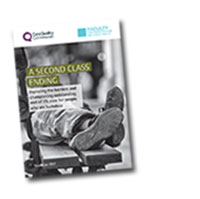Categories
Public
There is huge variation in the quality of care that people receive at the end of their life.

People whose needs are the most overlooked are often those who are least able to advocate for themselves. This is particularly true for people experiencing homelessness.
We have worked closely with the Faculty for Homeless and Inclusion Health, and draw on their research findings, to co-produce this discussion paper. This follows up our report A different ending: addressing inequalities in end of life care to further explore the barriers for this vulnerable group. We have also collaborated with and other experts in end of life care for homeless people.
Key discussion points
- The needs of homeless people are not well understood or considered by health and care services. Where services do exist, they are often fragmented and work in relative isolation.
- These issues are exacerbated by a lack of training and support for frontline staff.
- Identifying homeless people who may be dying is difficult. Involving homeless people in decisions about their treatment and care means striking the right balance between supporting them and respecting their individual choices.
- Actively linking health care, social care, housing and voluntary services may improve the care options available.
- Working together will help continuity of care - this needs a collaborative effort across services.
- There must be a strategic, equality-led approach at a local level, delivering personalised care. We share examples of excellent primary care and specialist community services.
- Hospices and primary care organisations in particular can play a key role in championing an equality-led approach.